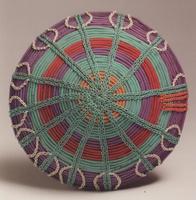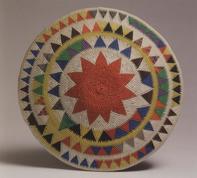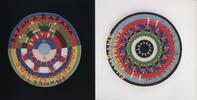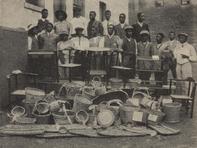The range of colours available to producers making artefacts from plastic coated telephone wire was initially extremely limited.

In the early 1990s, Marisa Fick-Jordaan of the Bat Centre in Durban convinced Intercable, a telephone flex manufacturer, to supply weavers with an expanded range of flex colours. Fick-Jordaan attributed her success in achieving this objective to the desire of suppliers to stem the growing theft of underground telephone cables, some of which was used to make wirework baskets and other items sold at tourist outlets.

Contemporary wirework platters evolved from the practice of using telephone wire to make coiled beer pot lids and to decorate the shafts of knobsticks night watchmen carried as defensive weapons.
These watchmen, who in urban areas guarded factories and other sites vulnerable to theft, were exempted from colonial legislation preventing other migrants from entering white settlements with potential dangerous weapons.
Initially, many of these men spent the long hours of the night embellishing their sticks with brass and copper wire and weaving beer pot lids (izimbenge, sing. imbenge) from indigenous grasses.
But early as the 1930s, largely because they lacked access in cities such as Durban and Johannesburg to the materials they had used until then, they began to work with discarded telephone wire covered in brittle synthetic materials.

The self-styled father of the contemporary plastic-coated wirework tradition, Mdegi Elliot Mkhize, claimed to have begun the practice of decorating sticks with multicoloured telephone wire while guarding the stage doors at the Natal Performing Arts Council in the early 1970s.
Mkize is an exceptionally skilled wirework weaver, but the idea of producing large, densely decorated coiled plates or platters rather than shallow bowls or izimbenge appears to have originated with Bheki Dlamini, who once worked with Mkhize at Fast Sales, a Durban-based company specializing in automobile re-upholstery.
This shift in scale was suggested to Dlamini by an American buyer, now only remembered by his first name - Ned - who met him at the Bat Centre in Durban in 1995. Dlamini became widely known for celebrating his love of soccer in his works. His career was cut short by his death from cancer in 2003.

In the late 19th century, Swiss Romande Missionaries working in southeastern Africa introduced carpentry, waggon building and the manufacture of baskets and mats into their schools.
Because artefacts like these were produced for sale to outsiders, the baskets made at these schools differed significantly from those used indigenously to winnow and sift, or store and carry grains and other foodstuffs, including watertight examples for liquids such as milk and beer.
One of the pupils at the Swiss school in Shiluvane in present-day Limpopo Province invented a new form of basket made from a single leaf of the Lala palms (Hyphaene coriacea) growing in the Leydsdorp plain south of present-day Tzaneen. Mats similar to those first made at these schools are still sold to this day at roadside stalls in South Africa’s Northern Province.
By Professor Sandra Klopper